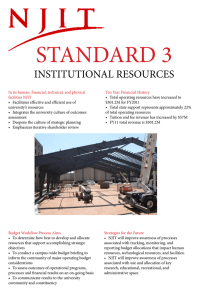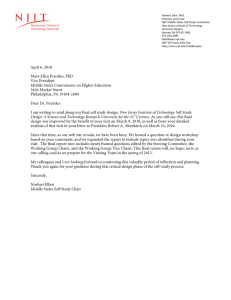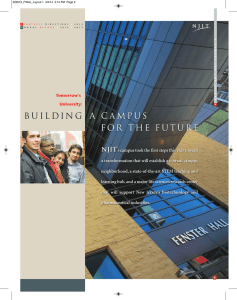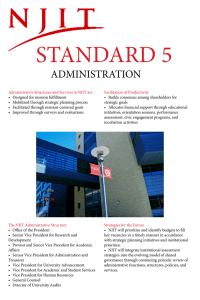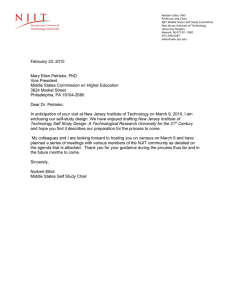NEW JERSEY INSTITUTE OF TECHNOLOGY FY 2005 BUDGET REQUEST
advertisement
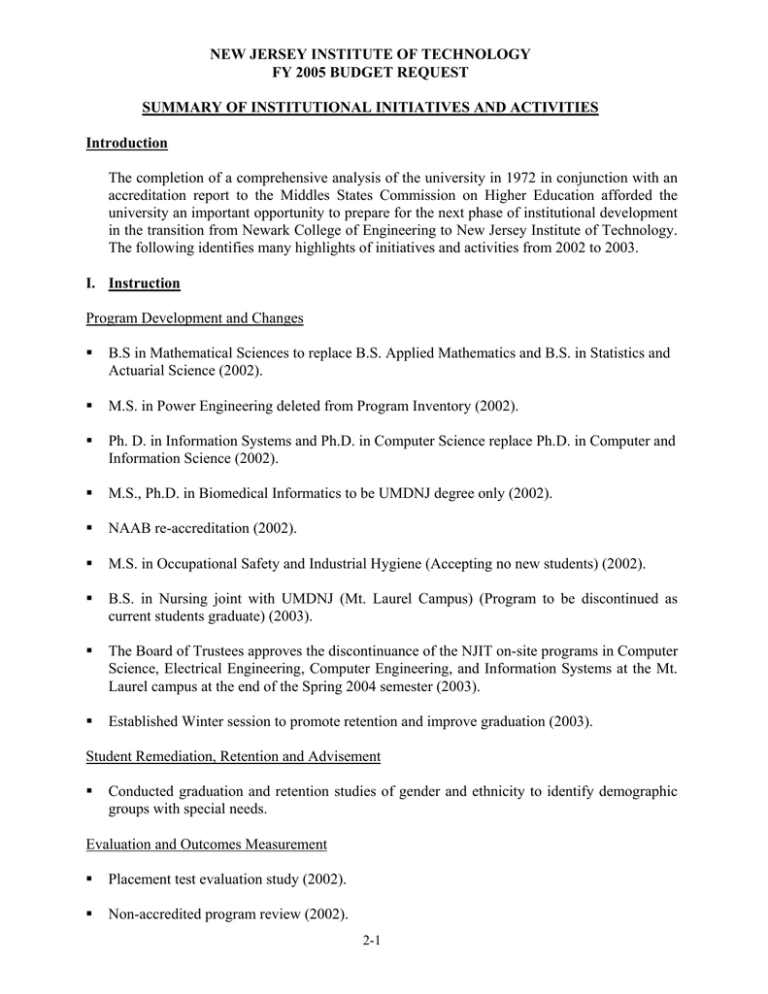
NEW JERSEY INSTITUTE OF TECHNOLOGY FY 2005 BUDGET REQUEST SUMMARY OF INSTITUTIONAL INITIATIVES AND ACTIVITIES Introduction The completion of a comprehensive analysis of the university in 1972 in conjunction with an accreditation report to the Middles States Commission on Higher Education afforded the university an important opportunity to prepare for the next phase of institutional development in the transition from Newark College of Engineering to New Jersey Institute of Technology. The following identifies many highlights of initiatives and activities from 2002 to 2003. I. Instruction Program Development and Changes B.S in Mathematical Sciences to replace B.S. Applied Mathematics and B.S. in Statistics and Actuarial Science (2002). M.S. in Power Engineering deleted from Program Inventory (2002). Ph. D. in Information Systems and Ph.D. in Computer Science replace Ph.D. in Computer and Information Science (2002). M.S., Ph.D. in Biomedical Informatics to be UMDNJ degree only (2002). NAAB re-accreditation (2002). M.S. in Occupational Safety and Industrial Hygiene (Accepting no new students) (2002). B.S. in Nursing joint with UMDNJ (Mt. Laurel Campus) (Program to be discontinued as current students graduate) (2003). The Board of Trustees approves the discontinuance of the NJIT on-site programs in Computer Science, Electrical Engineering, Computer Engineering, and Information Systems at the Mt. Laurel campus at the end of the Spring 2004 semester (2003). Established Winter session to promote retention and improve graduation (2003). Student Remediation, Retention and Advisement Conducted graduation and retention studies of gender and ethnicity to identify demographic groups with special needs. Evaluation and Outcomes Measurement Placement test evaluation study (2002). Non-accredited program review (2002). 2-1 NEW JERSEY INSTITUTE OF TECHNOLOGY FY 2005 BUDGET REQUEST SUMMARY OF INSTITUTIONAL INITIATIVES AND ACTIVITIES Enrollment Headcount of Underrepresented and Women (Approximate) 1972 Total Enrollment Headcount and Percent Full/Part-time, Graduate and Undergraduate 4.825 (100%) 8.770 (100%) Underrepresented Enrollment (Black & Hispanic) 120 (2.5%) 1,606 (18%) Women Enrollment 100 2,202 (25%) (2%) Fall 2003 In three annual (Money, Hispanic Outlook in Higher Education, Black Issues in Higher Education) national magazine surveys, NJIT ranks among the top 15 U.S. schools enrolling and graduating minority engineers. II. Research and Interdisciplinary Centers Research Growth Percentage Growth in Research Expenditures from 1992 to 2001 NJIT All NJ institutions Total from all sources Federal 109% 221% 61% 65% Interdisciplinary Research and Service Centers o o o o NJ Center for Wireless & Internet Security Vision Engineering Center NJ Nanotechnology Consortium Homeland Security Technology Center 2-2 NEW JERSEY INSTITUTE OF TECHNOLOGY FY 2005 BUDGET REQUEST SUMMARY OF INSTITUTIONAL INITIATIVES AND ACTIVITIES III. Computing Services A Network-Centered, Computing-Intensive Campus o NJIT provides a network-centered computing environment for faculty, students, staff, and researchers. The campus' Gigabit Ethernet backbone connects more than 5,900 nodes in classrooms, laboratories, residence halls, faculty and staff offices, the library, student organization offices, and others. The network provides access to a wealth of shared information services, all of which appear as standard network services, originating from a single source, and requiring a single point of authentication. Some of these include high-performance computer servers providing CPU cycles for simulation and computational research, disk arrays for storage of large data sets, communication servers for electronic mail and document exchange, databases, digital journal subscriptions, and a virtual "Help Desk." A virtual private network combined with Internet access, plus a large ISDN modem bank extend access to campus information resources to faculty, staff and students anywhere working at home, work, any of the university's many extension sites, or throughout the world. Students pay a semester technology infrastructure fee for support of these basic services. o Primary academic computing facilities are provided for faculty and students via a distributed computing environment using the Andrew File System (AFS). Faculty and students receive a single log-on account that provides access to hundreds of workstations on the campus network for programming, computation, Internet access, graphics, visualization facilities, and many other applications. The AFS environment provides seamless sharing of file data in a heterogeneous computing environment of Sun Solaris, SGI, Compaq Alpha, Windows, Linux, and Mac OS X workstations and servers. A 3 TB disk farm provides default equivalent storage of over 300 MB per students and 1 GB per faculty member. Additional disk allocations are available for special course and research projects. o Researchers with a need for high-performance computation have access to a number of high performance computation servers, the primary ones being SULCUS, an SGI 20-processor Origin 2000 server with 20 GB of RAM and FERMI, an SGI 28processor Origin 3400 with 28 GB of RAM. These servers support research computing for software requiring very large amounts of memory, high floating-point capability, and very fast direct memory access and disk I/O, as well as parallel processing. o TESLA, the university's Compaq OpenVMS academic system, provides access to specialized software not available in the Unix environment. o E-Learning and computerized conferencing are supported on two separate platforms: WebCT and WebBoard. The platforms are used as a primary or secondary meeting place for class lectures and group discussions for more than 2,000 students. The 2-3 NEW JERSEY INSTITUTE OF TECHNOLOGY FY 2005 BUDGET REQUEST SUMMARY OF INSTITUTIONAL INITIATIVES AND ACTIVITIES platforms also support some of the university's research groups in group communications and decision support systems. o Highlander Pipeline, the university’s campus portal, provides a single sign-on access and authentication to a wide variety of on-line services for faculty and students including campus news and announcements, e-mail, address changes, registration and transcripts, course schedules, financial aid, bill payment, class lists, faculty grade submission and much more. Additional features planned include employee time reporting and alumni portals. o The Academic Computing Facility in the Student Mall is home to four computer classrooms and some 200 PCs used by individuals or class reservations. The facility is available more than 16 hours per day during the academic year. Additional PC clusters are available in the Honors College Center, the Robert W. Van Houten Library, the University Learning Center, and many departmental facilities. o The Van Houten Library's Information Commons provides a convenient and relaxed atmosphere to search the Web, access electronic databases, view videotapes and other electronic archives of class lectures, and retrieve scholarly publications through digital library subscriptions. Reference librarians are available to help students sort through the vast amounts of information resources available and access what they need. o The Office of Instructional Technology and Media Services provides several facilities used for live and taped broadcast of telecourses as well as satellite downlinks for a wide variety of video teleconferences and other educational and public service satellite broadcasts. Several interactive television studio classrooms provide distance learning between Newark, corporate and other education centers. All classrooms are wired for Internet access with many rooms “technology-enabled” with multimedia PCs, projection devices, and video recorders. o Electronic communication is encouraged for all members of the university community and in many forms of university business. Faculty, students, and staff are issued e-mail accounts when they first arrive on campus, and the accounts are available for academic, business, and personal use subject to the university’s Acceptable Use Policy. Upon graduating, students are allowed to keep their e-mail accounts active for professional and personal use. Personal Computers o Since 1985, NJIT has provided each incoming first-time, full-time freshman with a personal computer for use at home or in the residence hall through graduation. More than 13,000 computers have been distributed in the eighteen-year span. Currently, 3,000 personal computers are in the hands of active students. Students pay a fee of $70 per semester for equipment maintenance. 2-4 NEW JERSEY INSTITUTE OF TECHNOLOGY FY 2005 BUDGET REQUEST SUMMARY OF INSTITUTIONAL INITIATIVES AND ACTIVITIES o For Fall 2003, the PC package, valued at $1,423, includes a Pentium IV 2.4 GHz processor, 512 megabytes of memory, an 80 gigabyte hard drive, a 64 MB video card, a 48x speed CD-RW Drive, a 250 MB Zip Drive, a network card, one 3 1/2 inch floppy disk drive, an enhanced 101 keyboard, a color VGA monitor, and an MScompatible mouse. Accompanying software includes Microsoft Windows XP, Microsoft Office XP Professional, FrontPage, Visio, Visual Studio Development Suite, and MatLab. NJIT also operates an on-campus Computer Maintenance Facility (CMF) offering hardware and software support for NJIT distributed computers. A Networked Campus o NJIT has constructed an information superhighway comprised of 600 miles of fiber optic cable and 800 miles of twisted pair cable that reaches every office, classroom and laboratory on the university's 45 acre, 29-building campus. Currently there are some 5,900 nodes directly connected to the network (up from 1350 in 1991). This total includes approximately 1,500 nodes for each student in each of NJIT’s five residence halls. o Access to NJIT’s wireless network is provided in the Library, most classrooms, public meeting rooms of academic buildings, residence hall lounges, dining facilities and on the campus green. o All campus buildings have a fiber inter-building link/backbone, using Gigabit Ethernet protocols. The backbone provides bandwidth for ease of use of graphic applications such as Multimedia, including interactive TV across the campus. o There are approximately 40 local area networks (LANs) on the campus. Of these, 22 provide connectivity for over 300 campus UNIX workstations. The remaining are Windows LANs serving approximately 2000 personal computers in offices, laboratories and student residence halls. Off Campus Connectivity o Initiation of Supercomputer Newark Remote Access Center (1985). Linked to John Von Neumann Center for Advanced Scientific Computing (1986). Increased access bandwidth to 56 kilobits per second line (1989). Linked to Pittsburgh Supercomputer Center Via NSF Net (1990). Increased the bandwidth to a T1 line (1.5 megabits per second) (1994). UUNet provides NJIT’s Internet connection services with dual connections at T1 speed (1996). UUNet service was upgraded to 6 megabits per second (1998) and now 21 megabits per second (2000) on a 45 megabits per second capable connection with a T1 backup line. In fall 2003 the university connected with NJ EDge.Net, New Jersey's Higher Education network, at a full OC-3 (155 megabits per second) circuit connection. o For local off campus access, NJIT maintains a pool of 140 digital modems operating 2-5 NEW JERSEY INSTITUTE OF TECHNOLOGY FY 2005 BUDGET REQUEST SUMMARY OF INSTITUTIONAL INITIATIVES AND ACTIVITIES at ISDN and 56,000 baud for general campus usage. IV. Administration and Planning Leadership and Administration o In place leadership at senior level: President, Provost and Senior Vice President for Academic Affairs, Senior Vice President for Administration and Treasurer, Vice President for University Advancement, Vice President for Academic and Student Services and Dean of Albert Dorman Honors College, Vice President for Research and Development, Vice President for Human Resources, Associate Vice President for Technology Development, Associate Vice President for Facilities Management, Associate Vice President for Continuing and Distance Education, Associate Vice President for University Advancement, Associate Treasurer, Dean of Newark College of Engineering, Dean of School of Architecture, Dean of College of Science and Liberal Arts, Dean of School of Management, Dean of Student Services, and Dean of Freshman Studies, Associate Provost for Information Services and Technology and Chief Information Officer, General Counsel and Assistant Vice President for Legal and Employment Affairs, Assistant Vice President for Graduate Studies, Assistant Vice President for Enrollment Planning, Assistant Vice President for University Budgeting, Assistant Vice President for Pre-College Programs, Assistant Vice President for Finance/Controller, Assistant Vice President for Human Resources, Assistant Vice President for Corporate and Foundation Relations, Assistant Vice President for Technology Development, Assistant Vice President for Government and Military Relations, Director of Institutional Research and Planning. o Codification and promulgation of certain policies as part of continuing policy review effort, e.g., affirmative action, purchasing/receiving, facilities guidelines, sexual harassment, travel, gifts-in-kind, partial return of research indirect costs to instructional departments, personnel policies and procedures manual, accounting manual, public safety, safety policies associated with biohazards, human subjects experimentation and radiation, vehicle use, smoke-free university, drug-free workplace, sick leave, use of facilities by faculty consultants, computing ethics and access to information, policy on AIDS, hiring procedures, tuition waivers, patent, copyright and promotion policies, procedures for approval, operation and review of research centers, joint appointments, involuntary emergency withdrawal of students with mental disorders, and access to campus by non-university groups. Planning o Middle States Self Study, including strategic plan. (2002). o Identified five strategic priorities consistent with the planning themes identified through the strategic planning process (2003). 2-6 NEW JERSEY INSTITUTE OF TECHNOLOGY FY 2005 BUDGET REQUEST SUMMARY OF INSTITUTIONAL INITIATIVES AND ACTIVITIES Financial Planning o Completed negotiations with Department of Health and Human Services on a fouryear Facilities and Administration Overhead rate. The F&A rate increased from 47% to 50% in FY04 and increases to 52% in FY07 (2003). Facilities Improvement o Planned rehabilitation of Eberhardt Hall, listed on the national register of historic buildings, to make it suitable as a new center for the Alumni Association and to provide conference and seminar facilities (2001). o Planned renovation of Cullimore Hall (2002). o Planned construction and occupancy of Enterprise Development Center III, East and West Buildings (2002). V. External Relations Establishment of a Vice President for Research and Development (2002). Public Affairs and Development o In 1993, the first stage of the most ambitious fundraising campaign in NJIT's history was launched by The Campaign Cabinet, led by the Chairman of the Board of Trustees Victor Pelson, class of 1959, and vice chairman, James Kennedy, chair of the university's Board of Overseers. The Campaign for NJIT: Design for the Future, was announced with a goal of $120,000,000 in public and private support. Early gifts were significant, ensuring that the campaign would be on track toward a successful conclusion at the end of the calendar year 2002. The focus for this campaign was student services, with special emphasis on endowment and scholarship support. In addition, the School of Architecture was relocated to a new building and received a challenge grant from the Kresge Foundation. Alumni, corporations and friends rallied to The Building Sciences Challenge, and thus secured major support from Kresge. Also during this period, Campaign support dramatically increased through personal and corporate gifts from the Board of Overseers, and through private foundations. The Campaign was completed in 2002 and exceeded the established goal. Over $181 million was raised, $81 million of which was from private sources. In addition, as a result of this Campaign, NJIT’s endowment was increased from $3.7 million in 1993 to $44.7 million in 2002. o In 2001 Leadership Circle included 1,416 donors (30% of the total number of donors), and contributed $2,620,047 (39% of the total dollars raised). In 2002 Leadership Circle included 1,508 donors (31% of the total number of donors) and contributed 2-7 NEW JERSEY INSTITUTE OF TECHNOLOGY FY 2005 BUDGET REQUEST SUMMARY OF INSTITUTIONAL INITIATIVES AND ACTIVITIES $4,370,038 (54% of the total dollars raised). In 2003 Leadership Circle included 1,482 donors (31% of the total number of donors) and contributed $4,025,547 (59% of the total dollars raised). o The Planned Giving Program was established in 1987 and emphasized gifts through wills, trusts and other instruments. The Gift Annuity Program received approval from the State Insurance Commissioner, and the first gift was received in 1992. As of October 2003, planned gifts totaled 212, almost doubling the number since 1995 with a total expectancy of more than $30 million. Albert A. and Joan B. Dorman funded a million dollar charitable remainder unitrust and Mandy Michaud pledged a bequest of six million dollars. Two years ago, the Jim Wise Bequest left NJIT $2.275 million. The NJIT Real Estate Gifts program was launched to market real estate as a way to make a significant charitable gift; Trudy Morse gave NJIT real estate in May 2003, which was sold for $650,000, from which proceeds established a gift annuity for her. In the 80’s, the 21st Century Club was established to recognize current planned gift donors and listed 95 members in 1997. In 1997, the name was changed to the 1881 Society and at the end of calendar year 2002, 128 members had joined. Laura E. and Wilbur J. Kupfrian ’33, ’35 have established the largest number of gift annuities, nine, and a trust that together are valued at 3 million. Appeals for how to prepare a will are the most popular with NJIT alumni and in today’s stock market, gift annuities have become very attractive to older alumni and friends. An aggressive marketing program is being implemented to attract additional planned gifts. o Annual Fund/Unrestricted Giving The Annual Fund/Unrestricted giving to NJIT had a significant boost in 2002 and 2003 due to a $2,275,000 bequest made by the late Professor James Wise. The Foundation continues to work to raise unrestricted dollars; however, donors are increasingly inclined to designate their gift to a department or college, and are not making unrestricted gifts as in the past. The Annual Fund Phonathon has seen significant increased pledge fulfillment over the past few years from 69% of pledges collected to 91% in 2003. In 2003, of the 3,374 pledges made, 3,082 were collected for a total of $211,037. o Web-based and Print Publications: NJIT Alumni Magazine (3), Annual Report, Impact, on-line Newsroom, NJIT corporate website, undergraduate Recruitment portfolio; on-line university catalog, graduate recruitment portfolio, university calendar (print), Safe and Sound. o Sponsoring and hosting of events serving the public and specific professional, technical and community-based organizations. Examples include: Newark Public Schools Math Fair, Newark Public Schools Computer Fair, READY Foundation Parent/Student Meetings, READY Foundation Teen Summit, Council for Higher Education in Newark (CHEN) meetings, New Jersey Young Filmmakers Festival, 2-8 NEW JERSEY INSTITUTE OF TECHNOLOGY FY 2005 BUDGET REQUEST SUMMARY OF INSTITUTIONAL INITIATIVES AND ACTIVITIES Communities in Schools Awards Ceremony, Engineering Career Day, New Jersey Department of Transportation meetings, Congressional symposiums and Department of Education training programs. Public Service Activities o NJIT runs a literacy program that involves over 350 students and partners with 75 non-profit agencies to provide more than 10,000 hours of volunteer time. o University Science Park continues to expand now expects to generate 3,000 jobs. Interinstitutional Cooperation o Articulation agreements with the following colleges: Bergen County College, Bloomfield College, Brookdale Community College, Burlington County College, Camden County College, Cumberland County College, Essex County College, Ramapo State College, Hudson County Community College, Mercer County College, Middlesex County College, County College of Morris, Ocean County College, Passaic County Community College, Raritan Valley County College, Stockton State College, Union County College, Seton Hall University, and Lincoln University in Pennsylvania. o Broad range of collaborative programs established with Rutgers and UMDNJ (26 programs are currently joint.) 2-9
